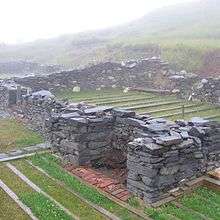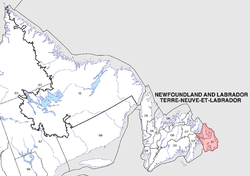Ferryland
Ferryland is a town in Newfoundland and Labrador on the Avalon Peninsula. According to the 2016 Statistics Canada census, its population is 414.[1]
Ferryland | |
|---|---|
Town | |
 Welcome sign | |
 Seal | |
| Motto(s): "Tolerance, Courage, Endurance" | |
 Ferryland Location of Ferryland in Newfoundland | |
| Coordinates: 47°01′N 52°53′W | |
| Country | |
| Province | |
| Settled | 1621 |
| Government | |
| • Type | Ferryland Town Council |
| • Mayor | Sean Walsh |
| Area | |
| • Total | 13.62 km2 (5.26 sq mi) |
| Elevation | 48 m (157 ft) |
| Population (2016) | |
| • Total | 414 |
| • Density | 30.4/km2 (79/sq mi) |
| Time zone | UTC-3:30 (Newfoundland Time) |
| • Summer (DST) | UTC-2:30 (Newfoundland Daylight) |
| Postal code span | A0A |
| Area code(s) | 709 |
| Highways | |
| Website | http://www.ferryland.com/ |
Seventeenth century settlement
Ferryland was originally established as a station for migratory fishermen in the late 16th century but had earlier been used by the French, Spanish, and Portuguese. By the 1590s it was one of the most popular fishing harbours in Newfoundland and acclaimed by Sir Walter Raleigh. Ferryland was called "Farilham" by the Portuguese fishermen and "Forillon" by the French—it later became anglicized to its current name "Ferryland." (This should not be confused with the Forillon National Park in Quebec, which still keeps its French name.)
The land was granted by charter to the London and Bristol Company in the 1610s and the vicinity became the location of a number of short-lived English colonies at Cuper's Cove, Bristol's Hope, and Renews and adjoined the colony of South Falkland. In 1620 the territory was granted to George Calvert, 1st Baron Baltimore who had obtained the holdings from William Vaughan. Calvert appointed Edward Wynne to establish a colony which became the first successful permanent colony in Newfoundland growing to a population of 100 by 1625. In 1623, Calvert's grant was confirmed and expanded. The Charter of Avalon was granted to Lord Baltimore by James I. Dated 7 April 1623 it created the Province of Avalon on the island of Newfoundland and gave Baltimore complete authority over all matters in the territory. That same year Baltimore chose Ferryland as the principal area of settlement. In the 1660s, the colony was attacked by the Dutch.
The town was destroyed by New France in the Avalon Peninsula Campaign (1696). Virtually forgotten for centuries, excavations of the original settlement began in earnest in the late 1980s and continue to this day.[2]
Historic designations
The site of the 17th-century Colony of Avalon was designated a National Historic Site of Canada in 1953.[3] It was also designated a Municipal Heritage District in 1998.[4]
The Historic Ferryland Museum was designated a Municipal Heritage Site in 2006.[5]
Gallery
 Excavated foundation of mansion house.
Excavated foundation of mansion house. Map of Ferryland in 1663
Map of Ferryland in 1663 Map of Ferryland in 1693
Map of Ferryland in 1693
See also
- List of lighthouses in Canada
- British colonization of the Americas
- List of cities and towns in Newfoundland and Labrador
- Sara Kirke
- Erasmus Stourton
- Ron Hynes
- James Tuck (archaeologist)
References
- Population and dwelling counts
- Colony of Avalon
- Colony of Avalon National Historic Site of Canada. Directory of Federal Heritage Designations. Parks Canada. Retrieved 8 July 2012.
- Colony of Avalon Special Preservation Area Municipal Heritage District. Canadian Register of Historic Places. Retrieved 8 July 2012.
- Historic Ferryland Museum Municipal Heritage Site. Canadian Register of Historic Places. Retrieved 8 July 2012.
External links
- Official Newfoundland and Labrador Tourism Website - Ferryland
- Ferryland - Encyclopedia of Newfoundland and Labrador, vol. 2, pp. 50–60.
| Wikimedia Commons has media related to Ferryland. |
| Wikisource has the text of the 1920 Encyclopedia Americana article Ferryland. |
